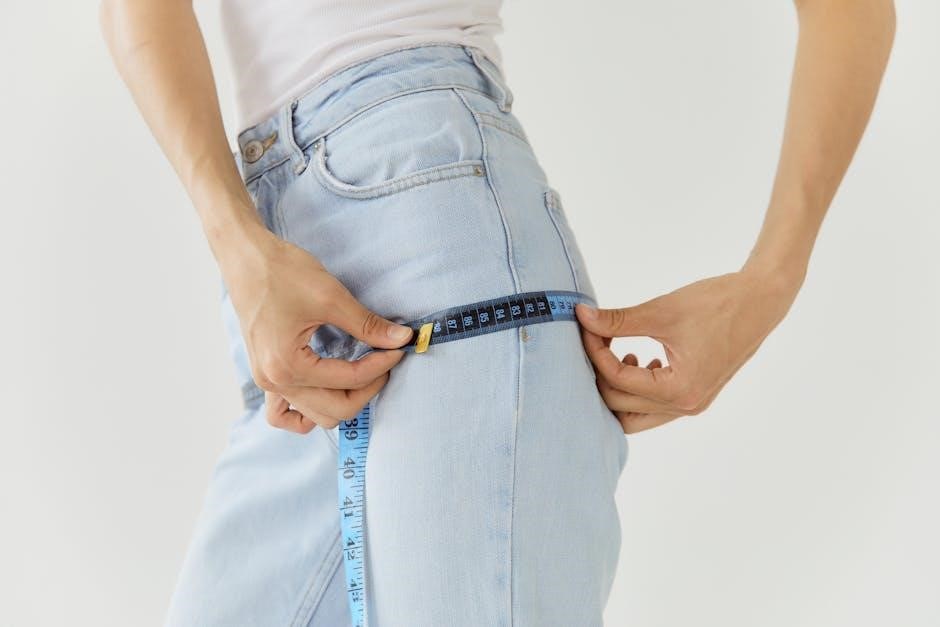Understanding shirt sizes is crucial for ensuring comfort and style. Key measurements include chest size, sleeve length, and shoulder width. This guide helps you choose the perfect fit, ensuring a perfect blend of comfort and style.
Importance of Understanding Shirt Sizes
Understanding shirt sizes is essential for ensuring both comfort and confidence. Proper sizing prevents discomfort from tight fits or unflattering looseness. It enhances style by creating a balanced, polished look. Accurate measurements, like chest size and sleeve length, ensure the best fit. This knowledge is especially crucial when shopping online, as it avoids the hassle of returns. Different brands often have slight variations, so relying on standardized size charts is key. By understanding your measurements, you can make informed decisions, ensuring your shirts look great and feel wonderful. This guide helps you master shirt sizing for a perfect fit every time.
How Shirt Sizing Affects Comfort and Style
Proper shirt sizing significantly impacts both comfort and style. A well-fitting shirt ensures freedom of movement, avoiding restrictive tightness or unflattering looseness. It creates a balanced silhouette, enhancing your overall appearance. Ill-fitting shirts can cause discomfort and detract from your style. For instance, a shirt that’s too tight may restrict arm movement, while one that’s too loose can look sloppy. Accurate measurements, such as chest size and sleeve length, are vital for a flattering fit. Different styles, like slim or oversized, cater to various preferences, ensuring both comfort and a polished look. Proper sizing ensures your shirts are both comfortable and stylish, making a lasting impression.

Measuring for the Perfect Fit
Measuring key areas like chest, sleeves, and shoulders ensures accuracy. Use a flexible tape measure and compare with a well-fitting shirt for precise sizing.
Essential Measurements for Shirt Sizing
Accurate measurements are vital for determining the perfect shirt size. Key measurements include chest circumference, waist, shirt length, shoulder width, and sleeve length. Chest is measured around the widest part, while waist is measured at the narrowest point. Shirt length is taken from the base of the neck to the desired hem. Shoulder width is measured across the back, from one shoulder tip to the other. Sleeve length is measured from the center back of the neck, over the shoulder, and down to the wrist. These measurements ensure a tailored fit, combining comfort and style effectively.
How to Measure Chest Size Accurately
To measure your chest size accurately, use a flexible tape measure. Place it around the widest part of your chest, typically just under your armpits and across your nipple line. Ensure the tape is level, not too tight or too loose, and parallel to the floor. Stand upright with your arms at your sides for a natural posture. Take the measurement and compare it to a shirt size chart to determine your fit. For the best results, measure more than once and average the readings. This ensures a precise fit, whether you prefer slim, regular, or oversized shirts. Accurate chest measurement is crucial for selecting the right shirt size and style.
Understanding Sleeve Length and Shoulder Measurements
Sleeve length is measured from the center back of your neck, over your shoulder, and down to your wrist bone. Shoulder width is measured across the top of your shoulders, from one shoulder tip to the other. Accurate measurements ensure a proper fit, preventing sleeves from being too short or too long. Shoulder measurements help determine how well the shirt sits on your frame. For casual shirts, sleeve length may vary, while dress shirts often require precise shoulder alignment. Ensuring these measurements align with the size chart guarantees comfort and style, whether you prefer slim-fit or relaxed shirts.

Types of Shirts and Their Sizing
Different shirt types, such as casual, dress, and graphic tees, have unique sizing requirements. Fit varies from slim to relaxed, with measurements like chest and length varying by style.
Casual Shirts: Fit and Sizing Considerations
Casual shirts, like t-shirts and polos, often have a relaxed fit. When choosing a size, consider your chest measurement and preferred fit, whether it’s snug or loose. Sleeve length and shirt length vary, with tall sizes offering longer options. Ensure comfort by matching your chest size to the chart, and check if the shirt runs true to size or if you need to size up or down. Fabric type can also affect fit, so consider stretch or softness for added comfort. Proper sizing ensures a stylish and comfortable casual look perfect for everyday wear or layering.

Dress Shirts: Specific Measurements and Fit
Dress shirts require precise measurements for a tailored fit. Key measurements include chest size, sleeve length, and shoulder width. Chest size is measured around the widest part, while sleeve length is measured from the center back of the neck over the shoulder to the wrist bone. Shoulder width ensures the shirt sits comfortably without stretching or sagging. Dress shirts often come in slim or regular fits, with specific measurements for each style. Proper sizing ensures the shirt fits well under jackets and looks sharp on its own. Always refer to the size chart to match your measurements for the best fit and comfort.
Graphic Tees: Differences in Sizing and Fit
Graphic tees often have unique sizing due to their design and fabric. They may be slightly shorter and wider than casual shirts, with a relaxed fit for comfort. Some graphic tees are oversized, offering a loose, trendy look, while others are fitted for a modern style. Measurements vary by brand, so checking the size chart is essential. Sleeve lengths can differ, with some styles featuring shorter sleeves for a vintage vibe. Fabric type also affects fit, as certain materials may stretch or drape differently. To ensure the best fit, compare your measurements with the chart and consider the design elements of the tee.

Men’s Shirt Size Guide
Men’s shirt sizes vary by style, with measurements for chest, waist, and sleeve length. Use size charts to ensure a perfect fit, balancing comfort and style effortlessly.
Understanding Men’s Size Charts
Men’s size charts provide detailed measurements to ensure the best fit. Chest size, waist, and sleeve length are key factors. Regular, slim, and oversized fits cater to different body types. Comparing your measurements to the chart helps avoid sizing errors. Always measure around the widest part of the chest and the narrowest part of the waist. Sleeve length is measured from the center back of the neck to the wrist bone. Ensure accuracy by using a flexible tape measure. This guide helps you navigate through various styles, ensuring comfort and style are never compromised. Proper fit enhances both appearance and comfort.
How to Choose the Right Size for Men’s Dress Shirts
Choosing the right size for men’s dress shirts involves precise measurements. Measure your chest around the widest point, ensuring the tape is level. Neck size is equally important, as it determines collar fit. Sleeve length is measured from the center back of the neck to the wrist bone. Compare these measurements to the size chart, ensuring a snug but comfortable fit. If your shirt size isn’t available, opt for the nearest size. Consider fit types like slim, regular, or relaxed based on your body type. Always check the fabric stretch and style to ensure the perfect blend of comfort and professionalism.
Men’s Casual Shirt Sizing Tips
For men’s casual shirts, ensure a comfortable fit by measuring your chest and comparing it to the size chart. Sleeve length should reach your wrist bone, and shoulders should align with your body’s natural fit. Opt for a relaxed style if you prefer a looser fit or a slim fit for a tailored look. Consider the fabric type, as stretchy materials offer flexibility. When in doubt, size up for a more laid-back vibe. Always check the shirt’s length to ensure it complements your pants or jeans. Pairing the right size with your body type ensures a stylish and comfortable casual look.

Women’s Shirt Size Guide
Women’s shirt sizing focuses on bust, waist, and length measurements. Use size charts to find your perfect fit, ensuring comfort and style for various body types and preferences.
Women’s Size Charts: Key Measurements
Women’s shirt size charts primarily focus on bust, waist, and hip measurements. These measurements ensure a perfect fit, combining comfort and style. The bust size is measured around the fullest part, while the waist is measured at the narrowest point. Hip measurements are taken around the widest area, typically 7-9 inches below the waistline. Standard U.S. sizes range from XS to 2X, with corresponding measurements to guide accurate sizing. Understanding these key measurements helps in selecting the right size, ensuring a flattering and comfortable fit for all body types and shirt styles.
How to Select the Perfect Fit for Women’s Tops
To select the perfect fit for women’s tops, start by measuring your bust, waist, and hips. Use these measurements to match your size on the chart. Consider the shirt’s style—fitted tops require precise measurements, while oversized styles offer more flexibility. Fabric type also matters, as stretchy materials may allow for a snugger fit. When shopping, choose a size that accommodates your largest measurement to ensure comfort. Pay attention to length and sleeve styles, as these can affect the overall fit. By combining accurate measurements with personal style preferences, you can find a shirt that flatters your figure and enhances your confidence.
Understanding Women’s Shirt Length and Fit
Women’s shirt length and fit vary based on style and personal preference. Cropped tops are shorter, ending above the waist, while hip-length shirts hit just below the hips. Tunic styles are longer, often reaching mid-thigh; Fit options include fitted, relaxed, or oversized. Fitted shirts skim the body, while relaxed styles offer more ease. Oversized shirts provide a loose, casual look. When choosing, consider your body type and how the shirt will be worn. For example, longer shirts pair well with leggings, while shorter styles are ideal for high-waisted pants; Ensure the fit aligns with your comfort and desired aesthetic.

International Size Conversion
Shirt sizes vary globally, with US, EU, UK, and Australian systems differing in measurements. Understanding these conversions ensures a perfect fit when shopping internationally, especially for chest size.
Converting US to EU Shirt Sizes
Converting shirt sizes from US to EU requires understanding the differences in sizing systems. US sizes are typically labeled as S, M, L, etc., while EU sizes use numerical measurements. For example, a US Medium often corresponds to an EU size 50 or 52, depending on the brand. Chest measurements are key, with EU sizes reflecting centimeter measurements of the chest circumference. To ensure accuracy, refer to a size chart, as conversions can vary slightly between brands. Understanding these differences helps avoid sizing errors when shopping internationally, ensuring a perfect fit for shirts across global brands.
Understanding UK and Australian Size Equivalents
UK and Australian shirt sizes often align closely with US sizes but have distinct differences. In the UK, sizes are typically labeled as S, M, L, etc., similar to the US, but chest measurements may vary slightly. Australian sizes also follow the S, M, L system but sometimes include additional fits like “Tall” or “Relaxed.” To convert, compare chest measurements: a UK Medium (chest 38-40 inches) corresponds to an Australian Medium. Both systems emphasize chest size as the primary measurement, ensuring accurate fit. Consulting a size chart is essential, as minor variations exist between brands, ensuring the best fit when shopping internationally.
Global Sizing Standards for Shirts
Global sizing standards for shirts vary by region, with key differences in measurement approaches. US sizes focus on chest circumference, while EU sizes often align closely with US standards but may differ slightly. Australian and UK sizes also emphasize chest measurements but include additional fits like “Tall” or “Relaxed.” Standard measurements typically include chest, sleeve length, and shoulder width. While there’s no universal system, most countries use similar size labels (S, M, L, XL). To ensure accuracy, refer to regional size charts, as minor variations exist between brands and countries. This ensures the best fit when shopping internationally.

Fit Types and Styles
Shirts come in various fits, including slim-fit for a tailored look, oversized for comfort, and classic for versatility. Each style caters to different preferences and body types.
Slim Fit vs. Regular Fit: What’s the Difference?
A slim-fit shirt is tailored closer to the body, offering a modern, streamlined look. It is ideal for those with a lean build, as it accentuates a slimmer physique. Regular fit shirts, however, provide more room through the chest, shoulders, and waist, offering comfort and versatility for various body types. Slim-fit shirts often have shorter sleeves and a narrower chest, while regular-fit shirts have a looser design. Choosing between them depends on personal style, body type, and desired comfort level. Both options ensure a polished appearance but cater to different preferences and needs.

Understanding Oversized and Relaxed Fits
Oversized and relaxed-fit shirts offer a looser, more comfortable silhouette. Oversized shirts are significantly larger, with a boxy shape and extended lengths, often used for bold fashion statements. Relaxed-fit shirts are slightly roomier than regular fits but not as exaggerated as oversized styles. Both cater to those who prefer ease of movement and a casual look. Oversized shirts often feature dropped shoulders and wider sleeves, while relaxed fits maintain a softer, natural drape. These styles are ideal for layering or everyday wear, providing a laid-back aesthetic without compromising on comfort. They suit various body types, offering a versatile option for casual wardrobes.
How to Choose the Right Style for Your Body Type
Choosing the right shirt style for your body type ensures a flattering and comfortable fit. Slim builds look great in tailored or slim-fit shirts, accentuating their physique. Athletic body types can opt for fitted shirts that highlight their broader shoulders and chest. For those with broader shoulders, spread-collar dress shirts create balance. If you have a larger midsection, relaxed-fit or overshirt styles provide a more forgiving silhouette. Petite individuals should consider shorter-length shirts to maintain proportions, while taller men can benefit from elongated styles. Understanding your body type and matching it with the right shirt style ensures confidence and a polished appearance.

Using a Shirt Size Chart Effectively
Take precise body measurements and compare them to the chart. Match your chest, sleeve, and shoulder measurements to find your ideal size for a perfect fit.
Interpreting Shirt Size Charts for Accurate Fit
To interpret shirt size charts effectively, start by identifying your key measurements, such as chest, sleeve length, and shoulder width. Compare these to the chart to find your closest match. Pay attention to fit types, like slim or regular, as they affect sizing. Measure around the widest part of your chest, keeping the tape level, and ensure your arm is slightly bent for sleeve length. Double-check your measurements to avoid errors. If you fall between sizes, consider your preference for a tighter or looser fit. Accurate interpretation ensures a comfortable and stylish shirt that meets your needs perfectly.
Common Mistakes to Avoid When Using Size Charts
When using shirt size charts, avoid relying solely on your usual size without checking measurements. Ignore assumptions based on previous purchases, as sizes vary between brands. Do not measure over clothing, as this can lead to inaccurate results. Avoid guessing your size without proper measurements. Neglecting to consider fit types, such as slim or regular, can result in poor fit. Do not overlook sleeve length and shoulder measurements, as they significantly impact comfort. Lastly, avoid hesitating to size up or down if your measurements fall between sizes. These mistakes can lead to ill-fitting shirts, so always double-check your measurements and the chart.
Matching Your Measurements to the Chart
To ensure the best fit, align your measurements precisely with the size chart. Start by identifying your chest size, as it is the most critical dimension for shirts. Compare your chest measurement to the chart to determine your base size. Next, check sleeve length by measuring from the center of your neck, over your shoulder, and to your wrist. Shoulder measurements should also align closely with the chart. If your measurements fall between sizes, consider sizing up for comfort. Pay attention to fit styles (e.g., slim, regular) as they affect how the shirt drapes on your body. Accurate matching ensures optimal comfort and style.
Mastering shirt sizing ensures comfort and confidence. Use detailed size charts, measurement guides, and fit tips for the perfect fit. Explore additional resources like size converters and style guides online for tailored solutions.
Recap of Key Points for Perfect Shirt Fit
Achieving the perfect shirt fit involves accurate measurements and understanding size charts. Measure chest, shoulders, and sleeve length precisely. Compare these measurements with size charts to select the right size. Consider fit types like slim, regular, or oversized based on your body type and preference. Ensure the shoulder seams align with your natural shoulder line for optimal comfort. Check sleeve length to ensure it reaches your wrist bone. Don’t hesitate to refer to international size conversions if shopping globally. Remember, proper fit enhances both comfort and style, making it essential for every shirt purchase.
Recommended Tools and Resources for Shirt Sizing
For accurate shirt sizing, use a flexible measuring tape to take chest, shoulder, and sleeve measurements. Refer to detailed online size charts, such as those provided by ASOS or Under Armour, for precise comparisons. Utilize apps like “Size Guide” or “Clothing Size Calculator” for digital assistance. Websites offering interactive fit guides, like Meesho or Snitch, can also help. Additionally, consult international size conversion tools to ensure the right fit when shopping globally. For visual guidance, watch YouTube tutorials on measuring techniques. Lastly, fashion blogs and retailer resources often provide tips for choosing the perfect fit based on body type and style preferences.